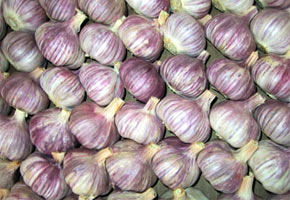

Garlic paste contains more allicin – a substance that fights cancer and cardiovascular disease – than fried garlic
Garlic paste contains more allicin – a substance that fights cancer and cardiovascular disease – than fried garlic
Garlic paste contains more allicin – a substance that fights cancer and cardiovascular disease – than fried garlic

Garlic paste contains more allicin – a substance that fights cancer and cardiovascular disease – than fried garlic
By Karina Toledo
Agência FAPESP – The flavor and therapeutic properties of garlic have been revered since antiquity, but garlic’s characteristic strong odor, which has even been thought to ward off vampires – causes many people to avoid handling raw garlic.
There are several forms of ready- to- eat garlic that obviate the need to handle the raw cloves. However, according to a study conducted by the São Paulo Agency of Agribusiness Technology (APTA), garlic can lose practically all of its functional properties during processing.
A research project funded by FAPESP and coordinated by agronomist Patricia Prati, compared three types of processed garlic: chopped and fried garlic, sliced and fried garlic and garlic paste.
The products were packaged in 200-gram plastic jars. Two percent citric acid was added to the paste, along with 0.1% potassium sorbate as a preservative.
All products were evaluated to determine the nutritional value immediately after processing and every 45 days thereafter during the six-month study period. “The main objective was to verify which method best preserves allicin, a substance that gives garlic its functional properties,” explains Conti.
According to the scientific literature, the antimicrobial action of allicin helps prevent stomach cancers caused by Helicobacter pylori . This compound also helps prevent cardiovascular disease by making the blood vessels more flexible and by preventing the formation of atherosclerotic plaques.
“Just after processing, garlic paste presents a small loss of allicin: 9.5%. At the end of six months, the level had dropped more than 20%. The total loss, however, was less than 30%, which is relatively little,” explains Prati.
Fried garlic, on the other hand, lost 90% of the allicin found in raw garlic. “In the analysis conducted during the first 45 days, the substance was practically unexistent,” says the scientist.
The level of vitamin C in the garlic paste was also evaluated, and although the level was relatively stable during the storage period, the initial level of vitamin C in the garlic paste was considered to be low. “We did not evaluate this nutrient in the fried product because we knew that nothing would be left after processing,” says Prati.
The analyses also showed that fried products became oxidized during the storage period, as demonstrated by the increased peroxide index. Despite the increase in the level of oxidation over time, the level was within the range required by law. The results of the microbiological analysis, which evaluated contamination by fungus and bacteria, were also within the legal limits.
Crops
Another objective of the study was to compare the suitability of four varieties of garlic for processing. Three varieties were from Brazil: Assai, Gigante de Curitibanos and Santa Catarina Roxo. The fourth variety was imported from China.
“Practically all garlic consumed in Brazil is imported from China or Argentina, depending on the time of the year. The national varieties are still not in the market, because they presented post-harvest problems, disease and plagues. But APTA and Embrapa are working on genetic improvement,” affirms Prati.
According to the study, all four varieties were found to be suitable for industrial processing. Santa Catarina Roxo was the variety with the highest levels of protein and lipids. The greatest concentrations of allicin were found in Gigante de Curitibanos and Assai. The levels of vitamin C were not significantly different among all varieties except Gigante de Curitibanos.
In addition to containing allicin and vitamin C, garlic is also rich in zinc and selenium, antioxidants that are directly and indirectly involved in the immune system. These substances, however, were not evaluated in this study.
Canada’s Ministry of Health and Germany’s Federal Health Agency recommend the ingestion of up to 4 grams of raw garlic daily or 8 milligrams of essential garlic oil to help control cholesterol and reduce cardiovascular risk. This amount of garlic is equivalent to approximately one and a half garlic cloves. In Brazil, there is no consensus regarding the ideal amount of garlic that should be consumed daily.
“Any type of cooking promotes the loss of certain functional properties of garlic, but frying it is the worst. Instead of cooking it first, it is better to put the spice in to cook along with the food,” says Prati.
Republish
The Agency FAPESP licenses news via Creative Commons (CC-BY-NC-ND) so that they can be republished free of charge and in a simple way by other digital or printed vehicles. Agência FAPESP must be credited as the source of the content being republished and the name of the reporter (if any) must be attributed. Using the HMTL button below allows compliance with these rules, detailed in Digital Republishing Policy FAPESP.





